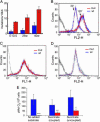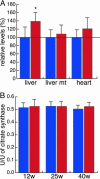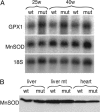Somatic mtDNA mutations cause aging phenotypes without affecting reactive oxygen species production
- PMID: 16332961
- PMCID: PMC1312403
- DOI: 10.1073/pnas.0508886102
Somatic mtDNA mutations cause aging phenotypes without affecting reactive oxygen species production
Abstract
The mitochondrial theory of aging proposes that reactive oxygen species (ROS) generated inside the cell will lead, with time, to increasing amounts of oxidative damage to various cell components. The main site for ROS production is the respiratory chain inside the mitochondria and accumulation of mtDNA mutations, and impaired respiratory chain function have been associated with degenerative diseases and aging. The theory predicts that impaired respiratory chain function will augment ROS production and thereby increase the rate of mtDNA mutation accumulation, which, in turn, will further compromise respiratory chain function. Previously, we reported that mice expressing an error-prone version of the catalytic subunit of mtDNA polymerase accumulate a substantial burden of somatic mtDNA mutations, associated with premature aging phenotypes and reduced lifespan. Here we show that these mtDNA mutator mice accumulate mtDNA mutations in an approximately linear manner. The amount of ROS produced was normal, and no increased sensitivity to oxidative stress-induced cell death was observed in mouse embryonic fibroblasts from mtDNA mutator mice, despite the presence of a severe respiratory chain dysfunction. Expression levels of antioxidant defense enzymes, protein carbonylation levels, and aconitase enzyme activity measurements indicated no or only minor oxidative stress in tissues from mtDNA mutator mice. The premature aging phenotypes in mtDNA mutator mice are thus not generated by a vicious cycle of massively increased oxidative stress accompanied by exponential accumulation of mtDNA mutations. We propose instead that respiratory chain dysfunction per se is the primary inducer of premature aging in mtDNA mutator mice.
Figures




Comment in
-
The mitochondrial theory of aging and its relationship to reactive oxygen species damage and somatic mtDNA mutations.Proc Natl Acad Sci U S A. 2005 Dec 27;102(52):18769-70. doi: 10.1073/pnas.0509776102. Epub 2005 Dec 19. Proc Natl Acad Sci U S A. 2005. PMID: 16365283 Free PMC article. No abstract available.
References
-
- Harman, D. (1956) J. Gerontol. 11, 298–300. - PubMed
-
- Harman, D. (1972) J. Am. Geriatr. Soc. 20, 145–147. - PubMed
-
- Balaban, R. S., Nemoto, S. & Finkel, T. (2005) Cell 120, 483–495. - PubMed
-
- Frenzel, H. & Feimann, J. (1984) Mech. Aging Dev. 27, 29–41. - PubMed
-
- Oliver, C. N., Ahn, B. W., Moerman, E. J., Goldstein, S. & Stadtman, E. R. (1987) J. Biol. Chem. 262, 5488–5491. - PubMed
Publication types
MeSH terms
Substances
LinkOut - more resources
Full Text Sources
Other Literature Sources
Medical
Molecular Biology Databases

